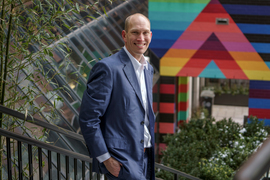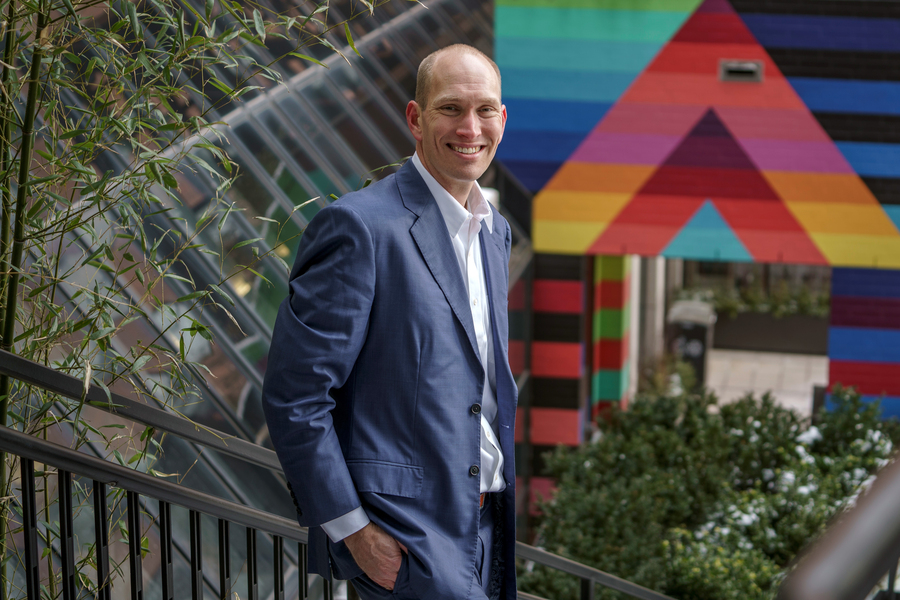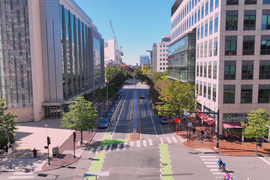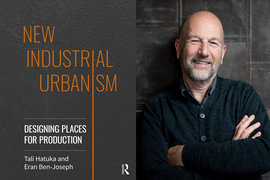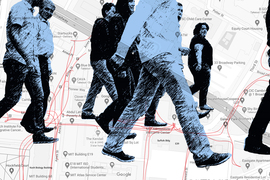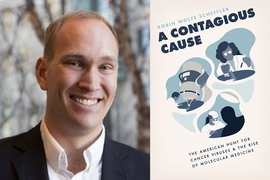For decades now, MIT’s Kendall Square neighborhood has been dotted by cranes, scaffolding, and construction sites — the unofficial symbols of the biotechnology boom that has made East Cambridge an industry capital.
True, there are other kinds of tech firms in Kendall Square, from Silicon Valley giants to startups. But the Kendall area is one of the places where the biotech business launched in the 1970s. It’s where blockbuster drugs have been developed and an innovative Covid-19 vaccine was created on short notice, and it keeps powering onward today.
“It’s the most vibrant biotechnology cluster in the world,” says MIT Associate Professor Robin Scheffler, a historian of science. “We are talking about a location that plays a huge role in defining the future of how biology can improve the human experience.”
Scheffler has become a historian of this transformation. An expert in the history of bioscience, he is currently writing a book about the rise and further rise of biotech in Kendall Square and greater Boston. Based heavily on original archival documents, Scheffler’s work will present a new look at everyday life in labs to further understand these companies, how innovation clusters function, and how medical innovations shape health care policy.
“A defining characteristic of Kendall Square’s ascendancy in biotechnology is its sheer density,” Scheffler says. “It’s so closely packed together and includes all these other dimensions of science and biology — hospitals, medical schools, and universities. Research and commercialization and production happen in this very small area.”
He adds: “Looking at the Boston area gives you a window into the evolution and growth of the industry as a whole.”
Studying the fairly recent past lets Scheffler illuminate how the scientific enterprise works today. Scheffler’s first book, “A Contagious Cause,” published in 2019, examined postwar fears that there was a general, transmittable “cancer virus.” A big federal funding effort in the 1960s helped prove otherwise, and in the process uncovered oncogenes — a driver of many cancers — while helping develop molecular biology. Meanwhile, researchers have since found other ways that viral illnesses are implicated in certain kinds of cancers.
In short, biotechnology moves rapidly and unpredictably, and there is never a bad time to analyze its progress. For his research and teaching, Scheffler earned tenure at MIT last year.
Building bridges
Asked about his own career trajectory, Scheffler — like many a good historian — can cite multiple factors to explain it, with some representing root causes. Scheffler has a long-standing inclination to find different fields of study fascinating, and to link them together. The history of science allows him to do that perpetually.
Growing up in California, Scheffler enjoyed philosophy, science, and math as a student, then attended the University of Chicago as an undergraduate and started redefining his interests a little.
“By the time I got to college I really enjoyed bridging things together,” he says. “I ended up being interested in two things, history and chemistry, that are both bridge-building fields. History bridges humanistic questions about life and experience with the social sciences, and chemistry bridges physics with biology.”
Scheffler received his undergraduate degree in both history and chemistry, and credits a few Chicago faculty from the time — Ronald Suny, Cathy Gere, and the late Alison Winter — with spurring his interest in the history of science. He earned a master’s degree in the history and philosophy of science from Cambridge University, supported by a National Science Foundation Graduate Fellowship — unusually for a historian of science — then moved to Yale University for his doctoral studies.
There, with historian of science Daniel Kevles as his advisor, Scheffler zeroed in on tumor viruses as his dissertation topic on its interdisciplinary merits.
“If I followed tumor viruses, I would have a historical object that allowed me to go to many realms: politics and policy, medicine, molecular biology,” Scheffler says. “I wanted to produce history that dissolved disciplinary divides. I think it’s important because it allows scientists to understand they are members of society and not just of the scientific community, but it also produces, I hope, a nuanced appreciation of what science can do.”
Scheffler also hit on a timely topic by publishing a major book on federally backed virus research just before the global Covid-19 pandemic occurred.
“Interest in viruses has spiked,” Scheffler says. “People want to know about the history of viral research in the 20th century, and regard it as a resource.” After the pandemic started, when Scheffler taught a course about biotech, he says, in class discussions, “Everybody’s example of biotechnology was a vaccine.”
Of his first book, he also notes: “Viruses were objects of an ambitious and positive effort to structure research. The overall vision that the government could step in to make [and support] a valuable contribution remains a very powerful idea. Having an appreciation for what was happening then, I hope, provides useful ideas for how to approach the present.”
A spotlight on “invisible technicians”
While wrapping up the book, Scheffler started writing a chapter about how the hunt for tumor viruses had helped create the contemporary biotech industry. But it did not quite fit with the rest of his material.
“I realized I wasn’t looking at the final chapter of a first book, I was looking at the outline of a second book,” Scheffler says.
After that dawned on him, Scheffler began researching the second project, centering it on the Boston area. And while some parts of the Kendall Square biotech boom have been well-documented, others remain less chronicled — such as the daily process of lab work that turns concepts into life-saving medicines.
“I’m very interested in what historians of science call ‘invisible technicians,’” Scheffler says. “We know a fair amount about biotech’s founders. I’m focused on people who are taking scientific ideas and transforming them into meaningful products. Otherwise, they’re just good ideas. Focusing on that level also knits the industry into the city of Cambridge, because that’s where the social dimension of this industry really takes place. It all stacks up in understanding how the world’s leading biotechnology cluster operates.”
Scheffler is looking in detail at the ways academia provides an essential talent pool for the biotech industry and serves as an anchor point for the Boston-area cluster of companies. He is also examining a full range of economic forces, urban planning issues, and other matters essential to thinking about the operations of any industrial cluster of companies. It does not hurt, he notes, to be living in the place he is studying.
“It’s been wonderful to get to know where I live, and understand the layers of history beneath my office in East Cambridge,” Scheffler says. “The opportunity to research this project while living in its midst is a special experience. People have provided me with great suggestions and observations.”
Meanwhile, the cranes and booms keep arriving in East Cambridge, the frames of buildings keep rising, and new firms keep exploring leading-edge concepts in medical research.
“At every single juncture, more companies arrive and it continues to grow,” Scheffler says.
